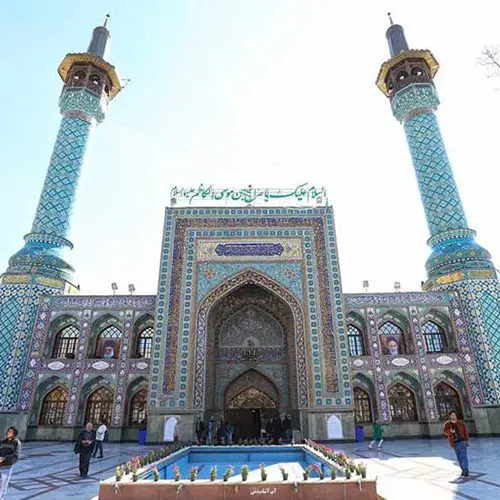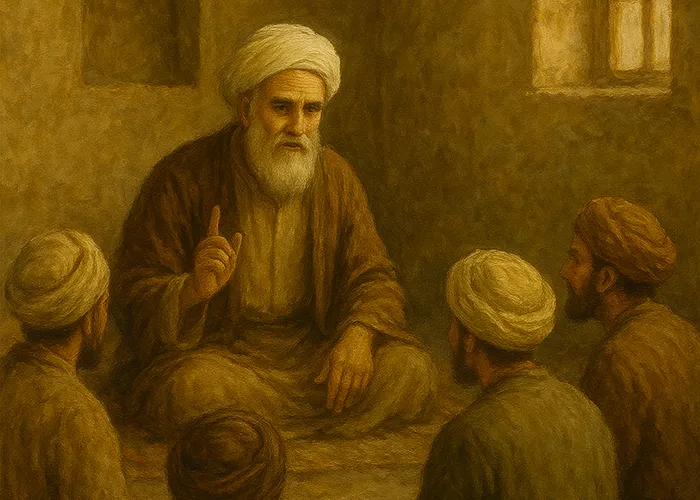Imamzadeh Saleh
Both a Blessing and a Sight to Behold
Introduction:
The 5th of Dhu al-Qa’dah, corresponding to the 3rd of May, marks the Day of Honoring the Holy Descendants of the Prophet (Imamzadehs) and Sacred Shrines in Iran. It is also dedicated to commemorating the noble figure of Hazrat Saleh ibn Musa al-Kazim (peace be upon him). In this week’s Friday bulletin, coinciding with the blessed days of the Ten Days of Dignity (Dah-e-Karāmat), we visited the sacred shrine of Imamzadeh Saleh—son of Imam Musa al-Kazim and brother of Imam Ali ibn Musa al-Ridha (peace be upon them)—to offer a humble tribute in honor of Imam al-Ridha.
In keeping with the tradition of our bulletin’s Guest of the Week section, where we interview scholars and preachers, this time we chose to explore the life and legacy of Imamzadeh Saleh in a Q&A format, bringing this noble figure closer to our readers.
Who was Imamzadeh Saleh?
Imamzadeh Saleh is a revered shrine located in Tajrish, in the north of Tehran. If you travel along Valiasr Street—the longest street in the Middle East—you will eventually arrive at this holy site. According to the inscription above the entrance and genealogical works such as Bahr al-Ansāb and Kanz al-Ansāb, Saleh was one of the sons of Imam Musa al-Kazim and a brother of the eighth Shi’a Imam, Ali ibn Musa al-Ridha.
How Did Imamzadeh Saleh Attain Martyrdom?
Historical accounts suggest that upon hearing news of Imam al-Ridha’s appointment as crown prince, Saleh set out from Iraq to Iran in order to visit his brother. However, he was martyred on his journey under an ancient plane tree near a spring. A man named Hassan Behbahani from the region of Karaj is said to have been in pursuit of him and ultimately killed him near Rey. In honor of this noble martyr, the locals erected a shrine, and ever since, the 5th of Dhu al-Qa’dah is commemorated annually at the site.
Why Do Iranians Revere Imamzadeh Saleh?
Due to his direct lineage with the Imams of Shi’ism, Imamzadeh Saleh is deeply revered by Iranians. His shrine has become one of Tehran’s most visited religious sites, hosting ceremonies throughout the Islamic calendar. Visitors include not only Iranians but also international Shi’a pilgrims, who make sure to include this ziyarat in their travel itineraries.
What Is the History of the Shrine?
The shrine of Imamzadeh Saleh is believed to date back to the Ilkhanid era (around 700 AH). Though the original builder is unknown, records show that in 1210 AH, Holaku, a son of Fath-Ali Shah Qajar, renovated the structure. He also changed the southern entrance to the western side and added turquoise tilework to the dome. His brother, Shuja al-Saltaneh, added a mosque, a Hosseiniyeh, and a bathhouse in the northern courtyard.
A rectangular clay plaque bearing Fath-Ali Shah’s name still exists at the entrance. The silver-latticed shrine was later donated by Mirza Saeed Khan, a late Qajar-era foreign minister. In 1338 AH, a benefactor named Hassan Fadakar re-tiled the dome. A more extensive renovation took place in 1368 SH, including a complete dome reconstruction and the addition of minarets and mirrorwork in the inner sanctums.
What Are the Architectural Features of the Shrine?
The most striking feature of the shrine is its turquoise dome and elegant minarets adorned with intricate tilework. Its architectural style reflects that of the 7th and 8th centuries AH, featuring thick walls, vaulted arches, and a square layout.
The shrine includes a northern courtyard with four riwaqs (prayer halls), originally surrounded by a cemetery, which was later transformed into a public park. Over time, the cemetery was closed for burials, and only historical traces remain.
What Is the Main Pilgrimage Area Like?
The main shrine area includes two riwaqs for men and two for women, all of which are mirror-tiled and adorned with beautifully crafted wooden doors. The original shrine chamber was only 6 by 6.5 meters, but it has since expanded to 50 square meters. The silver-wooden latticework (zarih) stands as the focal point for visitation and prayer.
What Is the Meaning of the Salt Vow?
One unique custom at Imamzadeh Saleh is the salt vow (nazr-e namak). Those whose prayers have been answered offer salt as a vow, which is then distributed among other pilgrims. This tradition originated when heavy snowfalls in Tajrish made pathways slippery. Locals began spreading salt to prevent injuries, and over time, the act became a symbolic vow associated with the shrine.
What Facilities and Spaces Exist at the Shrine?
Spanning 3,000 square meters, the shrine of Imamzadeh Saleh is among the largest in Iran. It comprises both historic and modern sections. The expansive courtyard contains the tombs of five anonymous martyrs, including nuclear scientists. These graves attract visitors who recite Fatiha prayers before continuing to the main shrine.
Why Is the Shrine Described as “Both a Blessing and a Sight to Behold”?
Imamzadeh Saleh sits amid various cultural and touristic attractions in northern Tehran. A few minutes’ walk brings you to the famous Tajrish Bazaar, one of Tehran’s oldest markets, filled with winding alleys and specialty shops for religious items, spices, and souvenirs.
Around the bazaar, you’ll find traditional eateries, historic mosques, and old hosseiniyehs. The shrine’s turquoise dome, mirror-tiled prayer halls, spiritual ambiance, vibrant street vendors, and proximity to Valiasr Street’s iconic plane trees make it a place where both the soul and the senses are enriched—truly, a site that is both a blessing and a sight to behold.
editor's pick
news via inbox
Subscribe to the newsletter.




